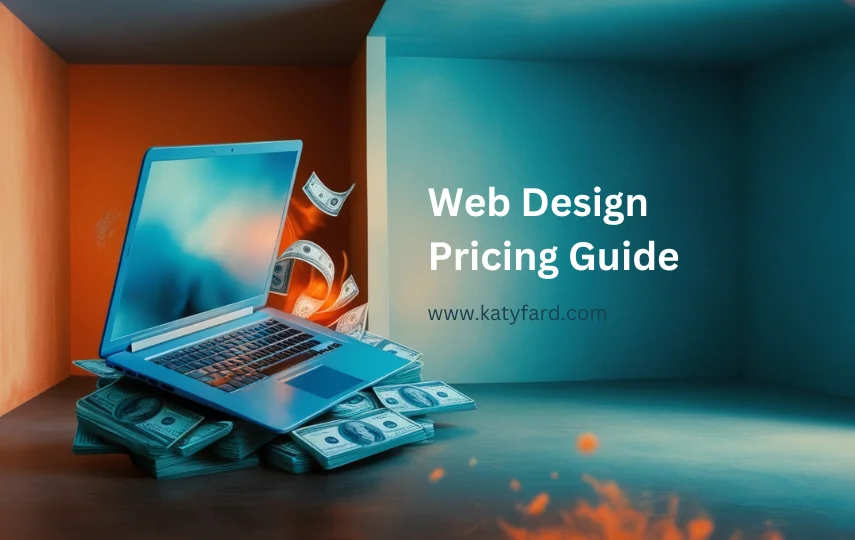In today’s digital age, a well-designed website is crucial for businesses and individuals alike. Whether you’re a client looking to hire a web designer or a designer planning to offer web design services, understanding the factors that influence web design pricing is essential.
If you’re looking for expert web design services, visit katyfard.com to explore my offerings.
1. Understanding the Basics of Web Design Pricing
Before diving into specifics, it’s important to understand what goes into web design pricing. Web design is not just about creating a visually appealing site; it involves coding, user experience (UX) design, search engine optimization (SEO), and often, content creation. The complexity of these tasks can vary significantly, which is why pricing can range from a few hundred dollars to tens of thousands.
Key Factors Influencing Web Design Pricing
1. Complexity of the Website: A simple blog will cost less than an e-commerce site with hundreds of product pages.
2. Customization: Custom designs are more expensive than using pre-made templates.
3. Functionality: Features like online booking, payment gateways, or membership areas add to the cost.
4. SEO and Content: Optimizing for search engines and creating content can increase the price.
5. Timeline: Urgent projects often come with a premium.
2. What Clients Should Consider When Budgeting for Web Design
As a client, your goal is to get the best value for your investment. Here’s how you can approach web design pricing:
a. Define Your Needs Clearly
Before approaching a designer, outline your website’s purpose, target audience, and essential features. This will help you avoid unnecessary costs and ensure you’re paying for what you truly need.
b. Research Market Rates
Web design prices can vary widely. In the U.S., for example, a basic website might cost between $1,000 and $5,000, while a more complex site can range from $10,000 to $50,000 or more. Researching these rates will give you a benchmark for negotiations.
c. Ask for a Detailed Breakdown
A good designer should provide a detailed quote that breaks down the costs for design, development, SEO, content, and any additional features. This transparency will help you understand where your money is going.
d. Consider Long-Term Costs
Web design isn’t just a one-time expense. Consider ongoing costs like hosting, maintenance, and updates. Some designers offer maintenance packages, which can be cost-effective in the long run.
3. What Designers Should Consider When Pricing Web Design Services
As a designer, your pricing should reflect your expertise, the value you provide, and the market demand. Here’s how to set fair prices:
a. Assess the Project Scope
Start by understanding the client’s requirements. How many pages does the site need? What features are they looking for? The more complex the project, the higher the price should be.
b. Factor in Your Time and Expertise
Calculate how many hours the project will take and multiply that by your hourly rate. If you’re an experienced designer, you can charge more for your expertise. For instance, senior designers often charge $100-$150 per hour, while beginners might charge $25-$50.
c. Include Hidden Costs
Don’t forget to account for expenses like software licenses, stock images, or third-party plugins. These costs should be included in your quote.
d. Offer Packages
Providing tiered pricing packages can make it easier for clients to choose a service level that fits their budget. For example, you could offer a basic package (template-based design), a standard package (custom design with basic SEO), and a premium package (fully custom design with advanced SEO and content creation).
4. Common Pricing Models in Web Design
There are several pricing models designers use, and each has its pros and cons. Understanding these can help both parties agree on a fair price.
a. Hourly Rate
This is straightforward: the designer charges by the hour. It works well for smaller projects but can become expensive for larger ones.
– Example: 50 hours x $100/hour = $5,000.
b. Fixed Price
The designer quotes a flat fee for the entire project. This is ideal for clients with a strict budget but requires a clear project scope to avoid misunderstandings.
– Example: $10,000 for a complete e-commerce website.
c. Value-Based Pricing
Here, the price is based on the value the website will bring to the client’s business. This model is great for high-value projects but can be harder to justify.
– Example: $20,000 for a website expected to generate $200,000 in annual revenue.
d. Retainer Model
The client pays a monthly fee for ongoing services like updates, maintenance, and SEO.
– Example: $500/month for website maintenance and content updates.
5. Tips for Negotiating Web Design Pricing
Negotiation is a crucial part of the web design process. Here’s how both parties can reach a fair agreement:
a. Be Transparent
Clients should be upfront about their budget, and designers should be clear about what’s included in their quote.
– Tip: “I have a budget of $5,000. Can we work within that?”
b. Prioritize Features
If the project exceeds the budget, prioritize the most important features and phase out the rest for future updates.
– Tip: “Let’s focus on the e-commerce functionality first and add the blog later.”
c. Offer Flexibility
Designers can offer discounts for long-term projects or bundle services to make the deal more attractive.
– Tip: “If you sign a 12-month maintenance contract, I’ll give you a 10% discount.”
6. Avoiding Common Pricing Pitfalls
Both clients and designers can fall into pricing traps. Here’s how to avoid them:
a. For Clients
– Don’t Choose Based on Price Alone: The cheapest option isn’t always the best. Look for value and quality.
– Avoid Scope Creep: Adding new features mid-project can inflate costs. Stick to the agreed-upon scope.
b. For Designers
– Don’t Undervalue Your Work: Charging too little can hurt your credibility and lead to burnout.
– Set Clear Boundaries: Avoid taking on too many revisions or additional tasks without adjusting the price.
7. When to Invest in Professional Web Design Services
While there are DIY website builders available, professional web design is worth the investment if you want a unique, high-performing site. Here’s when to consider hiring a pro:
– You’re launching a new business.
– Your current site isn’t converting visitors.
– You need advanced features like e-commerce or membership areas.
For exceptional web design services, visit katyfard.com to see how I can help you achieve your digital goals.
Conclusion
Web design pricing doesn’t have to be a mystery. By understanding the factors that influence costs and maintaining open communication, both clients and designers can agree on fair and logical pricing. Whether you’re a client looking for a stunning website or a designer aiming to set competitive rates, this guide has you covered. For expert web design services, don’t hesitate to reach out to me at katyfard.com.


How can we find our about our country web pricing??
Hello Shayan,
To find your country’s web pricing, research local web design agencies and freelancers for quotes. Check online platforms like Upwork or Fiverr for regional rates. Industry forums and social media groups can also provide insights. Comparing multiple sources helps gauge average costs for your specific needs.
Thank you.
How does the choice of a web design agency or freelancer impact the overall cost of a website project?
Hello Aston,
The choice between a web design agency and a freelancer significantly affects pricing. Agencies typically charge more due to their resources, expertise, and comprehensive services, while freelancers may offer lower rates but with limited capacity.
Thank you.
Hey Katy Fard
What are some red flags to watch for when negotiating a web design project?
Hi Lina,
According to my experience, clients who resist contracts, demand excessive revisions for free, set unrealistic deadlines, or focus only on the lowest price. Also, beware of vague project scopes, delayed payments, and clients who constantly change requirements without adjusting the budget. I hope these will be useful to you.
Thank you.
Also how can web designers justify their pricing to clients who compare them with cheaper alternatives?
Lina, a professional web designer offers custom, SEO-friendly, scalable websites that enhance user experience and business growth—unlike cheap templates that limit functionality and long-term success. Explain how expertise, strategy, and support lead to better results. Cheaper options often cost more over time due to poor performance, security risks, and lack of customization.
Very good
I’m glad it was useful for you.